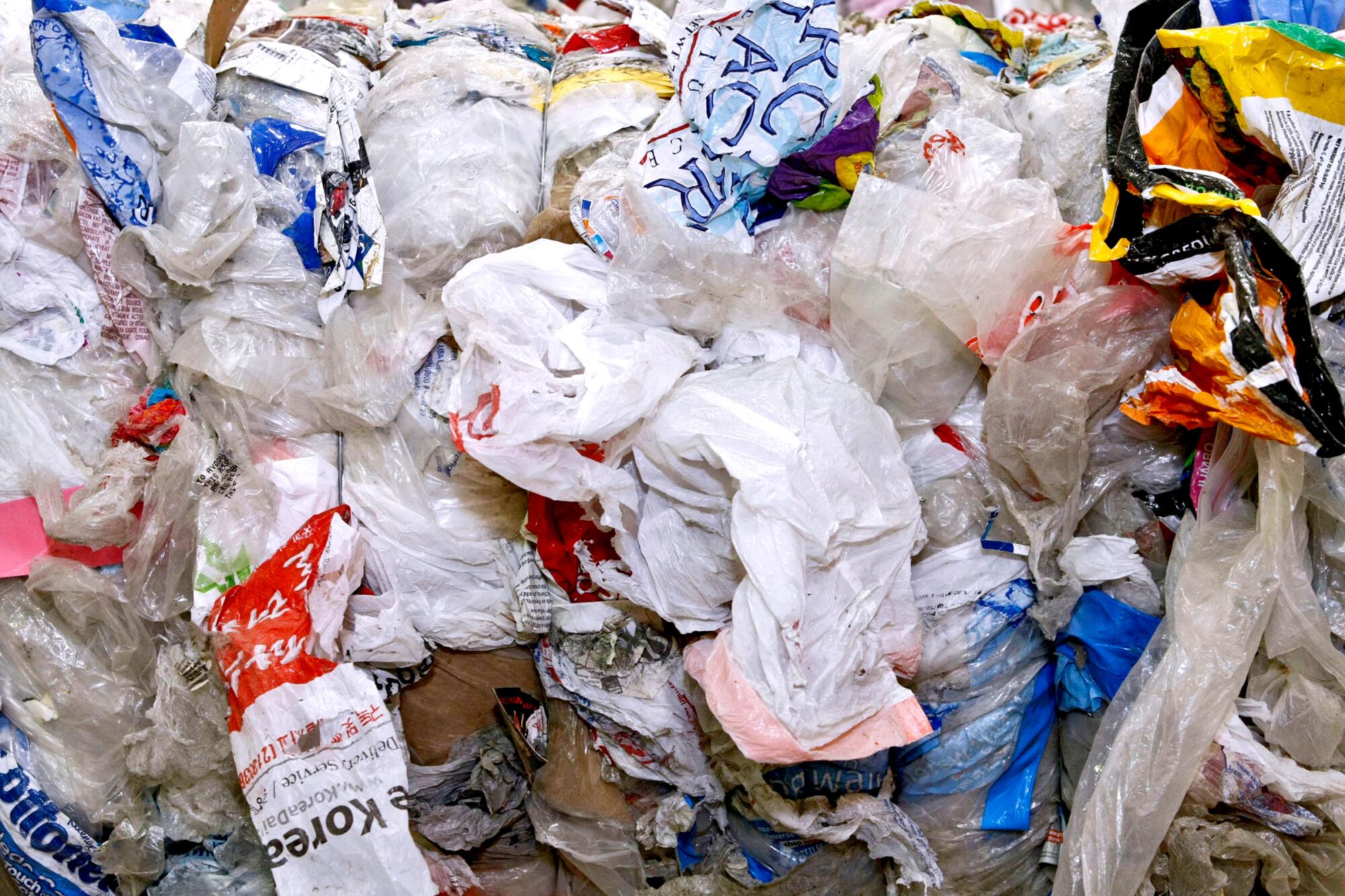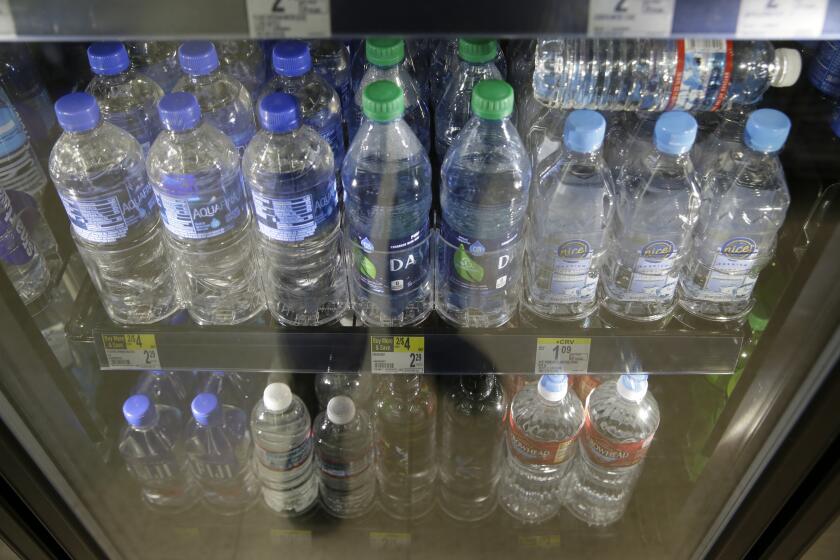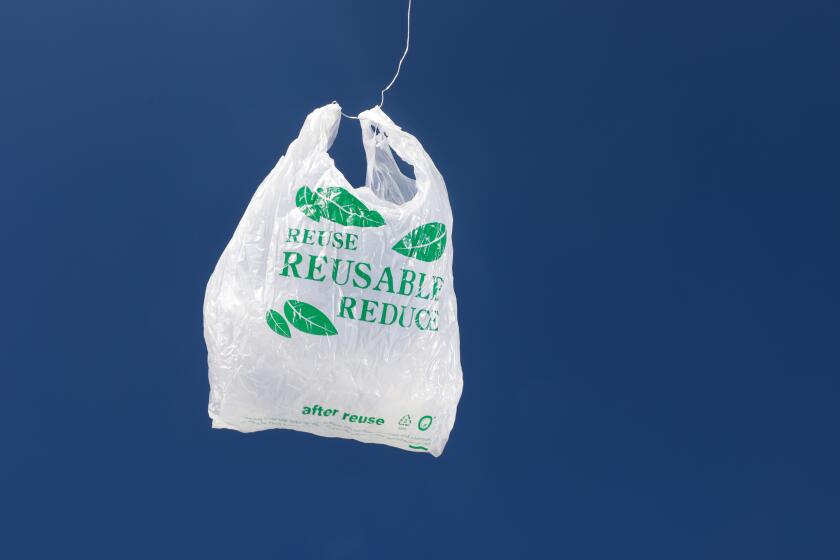
- Share via
It was a decade ago when California became the first state in the nation to ban single-use plastic bags, ushering in a wave of anti-plastic legislation from coast to coast.
But in the years after California seemingly kicked its plastic grocery sack habit, material recovery facilities and environmental activists noticed a peculiar trend: Plastic bag waste by weight was increasing to unprecedented levels.
Aggressive and impactful reporting on climate change, the environment, health and science.
According to a report by the consumer advocacy group CALPIRG, 157,385 tons of plastic bag waste was discarded in California the year the law was passed. By 2022, however, the tonnage of discarded plastic bags had skyrocketed to 231,072 — a 47% jump. Even accounting for an increase in population, the number rose from 4.08 tons per 1,000 people in 2014 to 5.89 tons per 1,000 people in 2022.
The problem, it turns out, was a section of the law that allowed grocery stores and large retailers to provide thicker, heavier-weight plastic bags to customers for the price of a dime.
“It was a conscious decision to create a pathway for a type of reusable bag that barely existed,” said Mark Murray, director of Californians Against Waste, an environmental organization. “It was just emerging in the marketplace, but it happened to be made by a couple of California companies ... which the manufacturers claimed they could certify as being reusable.”
He said the bags were made of 20% recyclable material and the manufacturers said they could be recycled at the end of their “useful life. ... So we said, all right, fine. We’re gonna put that specific criteria into the law.”
“That experiment failed,” Murray said.
“It was a gaping hole,” said Mark Gold, director of Water Scarcity Solutions, Environmental Health at the Natural Resources Defense Council who worked on the original legislation — SB 270 — while he was with the organization Heal the Bay.
These “reusable” bags are made from a material known as HDPE, which is thicker and heavier than the LDPE plastic bags of yore. And although both materials can be recycled — and in commercial and agricultural settings often are recycled — they are generally not in residential and consumer settings, Murray said.
“Basically what happened is that plastic bag companies invented these thicker plastic bags that technically meet that definition of reusable but are clearly not being reused and don’t look like reusable bags and which just circumvent the law’s intent,” said Jenn Engstrom, CALPIRG’S state director.
Nanoplastics are microscopic flecks so small that they can be absorbed into human cells and tissue, as well as cross the blood-brain barrier.
Now, California legislators are hoping to correct that error by passing a law that closes that loophole and bans those thick plastic bags offered at the checkout line.
“The idea is to go back and redefine reusable bags as a way to get rid of all those setbacks that we’re now seeing very commonly in grocery stores,” Engstrom said.
Thick plastic bags are “not what consumers demanded when they overwhelmingly voted to support California’s bag ban at the ballot box when the policy was challenged,” Sen. Ben Allen (D-Santa Monica) told reporters recently in reference to Proposition 67, a 2016 ballot measure that would have negated the 2014 law.
“Californians want less plastic, not more.”
The proposed legislation was co-authored by Allen, Assemblymember Rebecca Bauer-Kahan (D-Orinda) and Sen. Catherine Blakespear (D-Encinitas).
Research has shown that the plastic problem is growing.
Plastic has been found everywhere scientists have looked: From the deepest oceanic trenches to the highest alpine peaks. Petroleum-based plastics do not biodegrade. Over time, they break down into smaller and smaller pieces — known as microplastics, microfibers and nanoplastics — and have been found in household dust, drinking water and human tissue and blood.
These small plastic pieces also carry chemicals and heavy metals known to cause illness and disease.
“If you’ve been paying attention and reading the news, looking around, you realize that we are literally choking our planet with plastic waste,” Blakespear said at the news conference. She noted that 5 trillion bags are used every year across the globe — and that the average use time per bag is 12 minutes.
California’s plastic bag ban aimed to reduce waste and increase recycling, but it hasn’t worked out as planned. What went wrong?
Part of the issue has to do with the promises that product manufacturers made about recycling, and the hard realities of plastic collection and reuse. In 2018, the Environmental Protection Agency estimated that just 8.7% of all plastics were actually recycled.
In 2022, California Atty. Gen. Rob Bonta opened an investigation into the fossil fuel and petrochemical industries for their alleged role in causing and exacerbating a global crisis in plastic waste pollution, and for deceiving the public into thinking recycling could solve the problem of plastic waste.
Allen and Engstrom said states such as New Jersey and New York followed California’s move toward banning plastic bags but learned from California’s mistake and crafted legislation to close the loophole.
“There’s this virtuous cycle of dialogue between those states that want to do the right thing where we we build on each other’s work and almost challenge each other” to write effective, all-encompassing laws, Allen said.
He also said he anticipates a pretty clear road for this legislation as it moves through the Assembly and Senate, in large part because it is supported by the California Grocers Assn.
Daniel Conway, the association’s vice president for government relations, described the original plastic bag ban legislation as “revolutionary,” but “at the same time, I think like most good laws, you have to take a look and adapt to changes in the world that we live in.”
Gold wasn’t surprised the first law didn’t work.
“This is what happens when you try to fight plastic one item at a time,” he said. “It’s just not effective at stemming the plastic problem.”
He said a far better approach was SB 54, a bill that Gov. Gavin Newsom signed into law in 2022.
That sweeping law seeks to phase out single-use plastics through a policy concept known as Extended Producer Responsibility, which shifts the onus of waste from consumers, towns and cities to companies manufacturing products with environmental impacts.
The law also grants plastics companies extensive oversight and authority in terms of the program’s management, execution and reporting, via a Producer Responsibility Organization, which will be made up of industry representatives.
The legislation requires that by Jan. 1, 2028, at least 30% of plastic items sold, distributed or imported into the state be recyclable. By 2032, that number rises to 65%. It also calls for a 25% reduction in single-use plastic waste by 2032 and provides CalRecycle with the authority to increase that percentage if the amount of plastic in the economy and waste stream grows.
In the case of expanded polystyrene, that number needs to reach 25% by 2025. If the number isn’t hit, the ubiquitous, hard-to-recycle foamy plastic will be banned.










